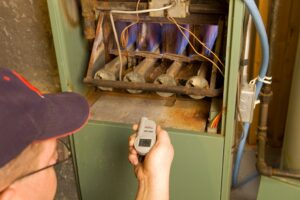 If you’re like many homeowners here in the Florence area, there’s a good chance that you use a gas-powered furnace to keep your home and family warm. Furnaces are a great choice—both powerful and cost-efficient when properly installed and well-maintained. Today’s furnaces have an even higher efficiency rating than ever before. In fact, the highest rating now available for a gas furnace is 98%.
If you’re like many homeowners here in the Florence area, there’s a good chance that you use a gas-powered furnace to keep your home and family warm. Furnaces are a great choice—both powerful and cost-efficient when properly installed and well-maintained. Today’s furnaces have an even higher efficiency rating than ever before. In fact, the highest rating now available for a gas furnace is 98%.
But this efficiency doesn’t mean much if you aren’t using your furnace as safely as possible. Furnaces are not inherently dangerous, but there are components within them that could cause one to become dangerous if it misses professional services, such as annual tune-ups.
The heat exchanger is one example of this. A cracked heat exchanger is definitely a potential hazard, and we’re going to dive into the “why” behind this below. While this problem is more common in an older system (10–15 years old), we encourage you to keep this information on hand and stay on top of your maintenance appointments even if you have a brand new system! Read on to learn more.
The Job of the Heat Exchanger
This component is vitally important to the operation of your gas furnace. Heat exchangers are the component where heat from combustion gases collects to heat up the metal walls: the air from your furnace’s blower fan moves over them, so that heat is transferred into your living space. In other words, heat exchangers are literally the component of your furnace responsible for heating your home!
What happens is that combustion gases enter a “clamshell-like” chamber—the heat exchanger—and raise the temperature of the metal walls on the exterior. The blower fan then pushes air over those metal chambers, and the heat is transferred into the air. Then the air travels through your air ducts and into your home. This means that these metal walls of the heat exchangers are the only thing that stands between the combustion gases and your indoor air.
The Danger of a Cracked Heat Exchanger
Over time, wear and tear affects your furnace, including the heat exchangers. Each time the heat exchangers get hot, their metal walls expand. They contract when they cool down. After years of expanding and contracting like this, they are susceptible to corrosion and subsequent cracks.
These cracks are small—invisible to the naked eye even. However, when the heat exchangers get hot again and expand, the cracks open up and can leak combustion gases out–with the most harmful of these gases being CO (carbon monoxide). CO exposure is a leading cause of illness and even fatalities in American households.
If a furnace continues to run with a damaged heat exchanger, it increases the risk for you and your family. The best thing you can do is make sure you’re scheduling maintenance regularly for your heater, so we can check on the heat exchanger and all the other components of your furnace. We’ll ensure your system is running efficiently and safely, each and every year. Additionally, we urge you to have carbon monoxide detectors installed in your home so you’ll have a clear warning if you are exposed to this gas!
For expert service on your heating in Florence, OR, look no further than Comfort Flow Heating. Contact us today!
